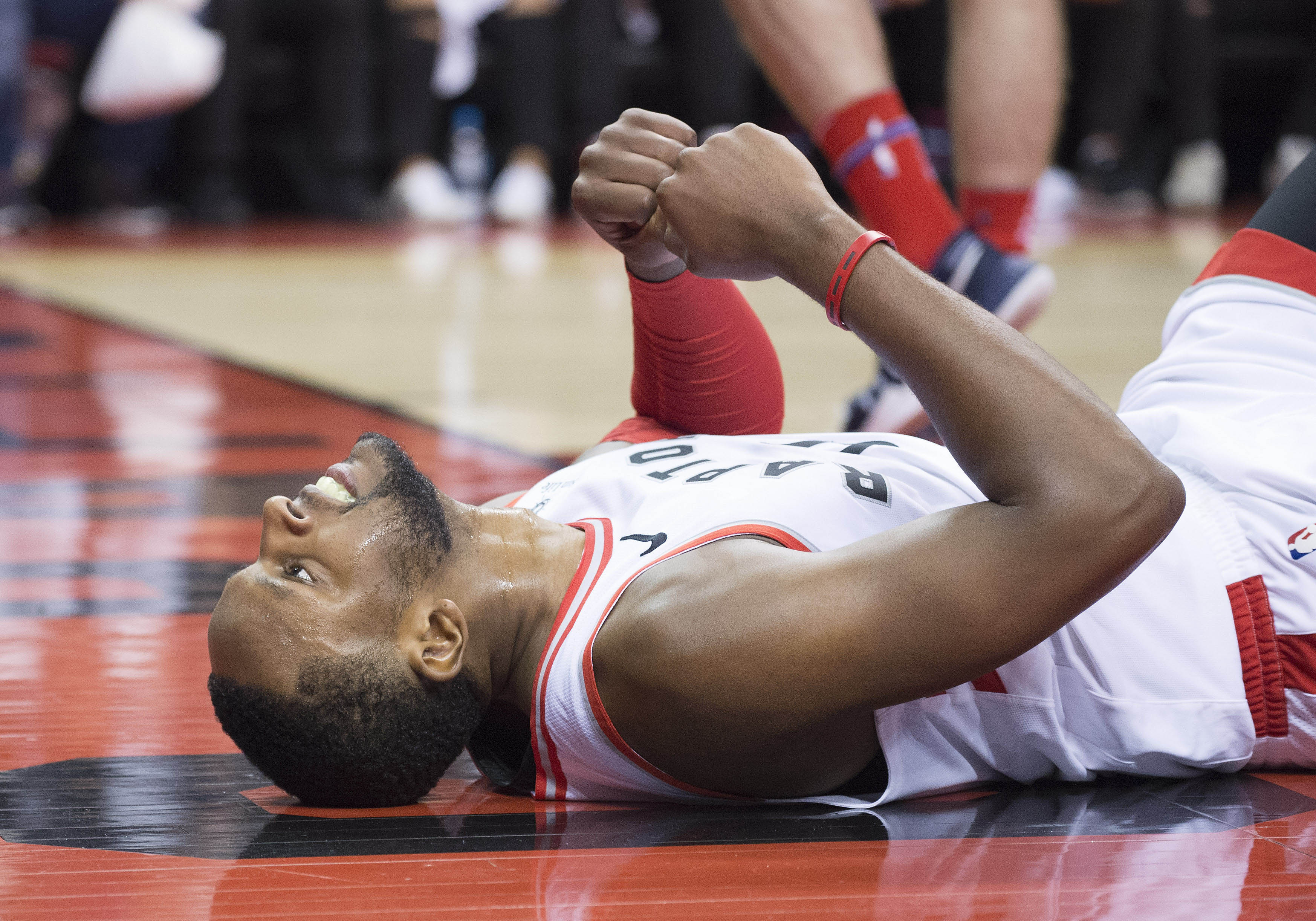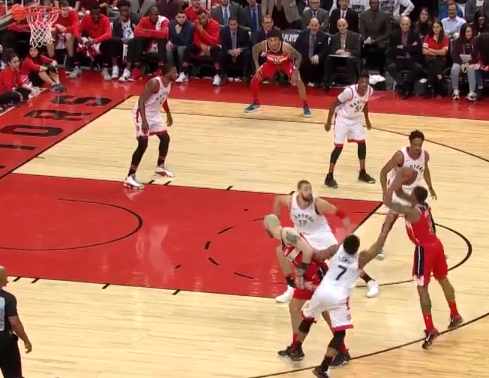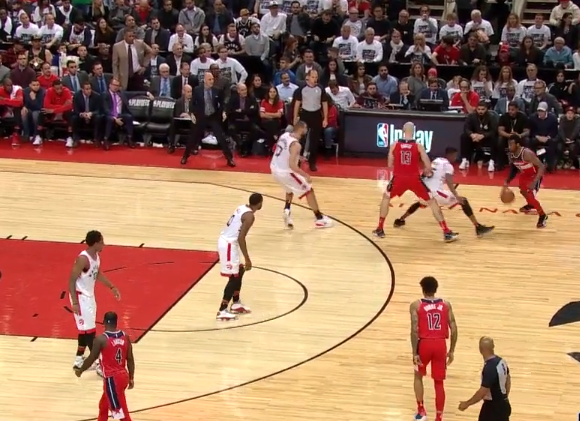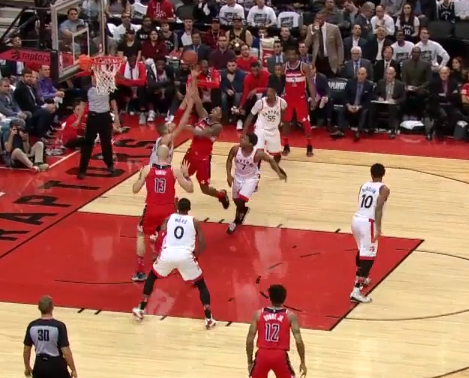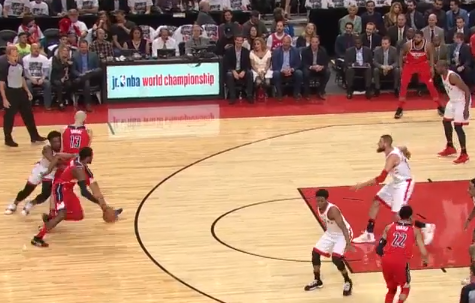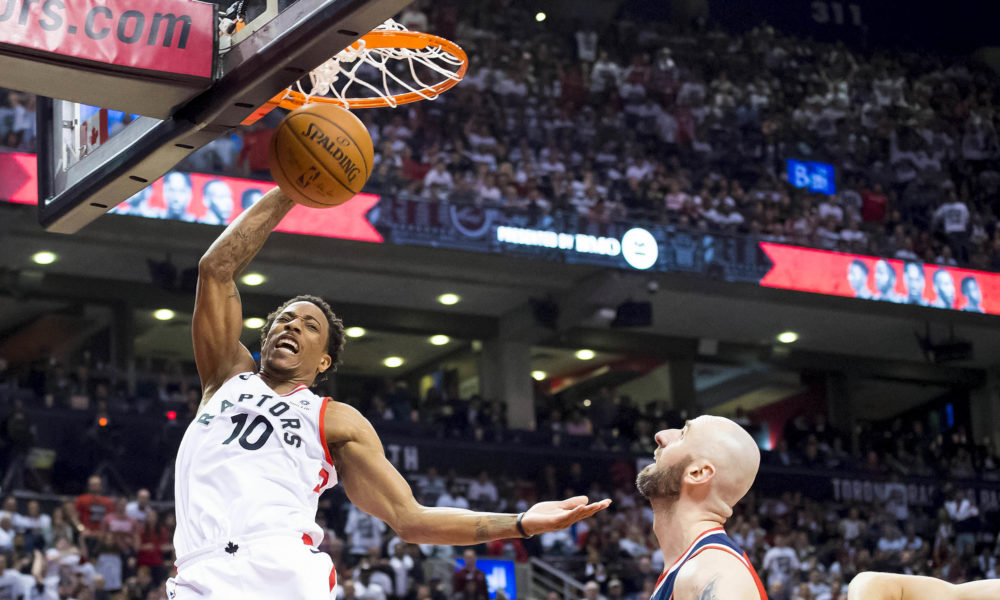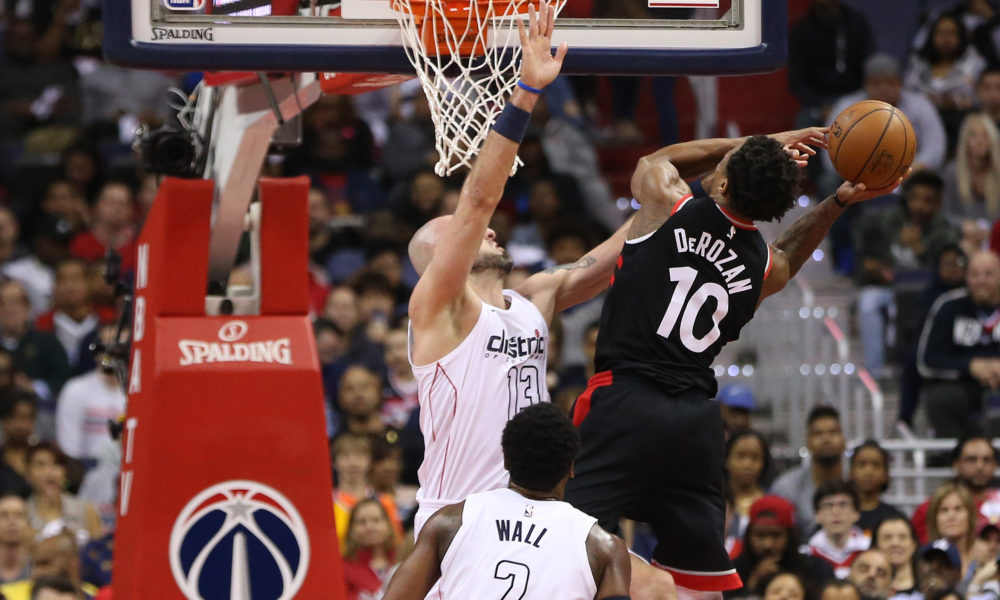Something came up for the person who originally had this slot on the schedule and I somehow still have more to say about the close-out of Game 5 (on top of the post-game notes and the recap), so we’re going to tackle a couple of things in a more rapid fire approach. (I kind of miss doing Zarar-style posts like this, addressing a number of smaller things instead of one big idea.)
That closing lineup
I mentioned this in the post-game, and it warrants repeating:
The group the Raptors closed with played all of seven minutes together this year with a -28.8 net rating. Here, they were +18 in nine minutes and were solely responsible for taking control of this game and closing it out.
The Raptors did that in Game 1, too:
The Raptors’ closing lineup of Lowry-Wright-DeRozan-Ibaka-Nogueira played nine minutes together chopped over five different games this season. They played four here, and while they earned a -2, that’s fine given that they were in lead-holding, clock-eating mode. The lineup that preceded it with Miles and Siakam in place of DeRozan and Ibaka was +8 in four minutes. That lineup played one minute together this year. Obscene depth.
This is, of course, terrific. The Raptors are deep enough to keep mixing and matching when the standard units aren’t working, and they have enough multi-faceted talents to play to the opponent and situation. Things may have been more straight-forward if Fred VanVleet were around, but he isn’t, and Dwane Casey has pushed the right buttons in three of the four games where the buttons he pressed mattered (I did not love the Game 4 second-half rotations, and Game 3 wasn’t lost on that front).
It’s at least a little bit concerning, though. Not because the Raptors can’t do this – they quite obviously can – but because needing to do so says some things as well. The starting lineup is still the only group that’s played more than 16 minutes together in the series – Kyle Lowry and the bench has been a slight positive in 16 minutes, DeMar DeRozan and the bench a significant negative in 15, and the all-bench unit with Norman Powell in VanVleet’s spot a tenuous positive in 14 minutes, and no other group has played 10 minutes – and the Raptors have tried 44 different lineup combinations through five games. Again, depth is great, and Casey’s willingness to break from his regular rotation pattern when things aren’t working is commendable. You’d like for that to not be necessary, though, because figuring out the “right” five night-to-night is a little difficult and because some of the combinations that have clicked (the Delon Wright-Jonas Valanciunas pairing, for example) or haven’t (Serge Ibaka and Jakob Poeltl) have a track record of not being all that effective.
Of course, all of that is to also say the Raptors are managing around injury and ineffectiveness well, Casey is making mostly good adjustments throughout, and players like Wright are really stepping up in unfamiliar settings. And the Raptors still haven’t even called on OG Anunoby, unquestionably one of their five best players in the series so far, for fourth-quarter minutes.
The Wizards in the mid-range
Entering the series, one of the most interesting tactical storylines was how the battle in the mid-range on Toronto’s end would play out. The Raptors invite teams to shoot mid-range shots better than almost anyone, and the Wizards are more willing to – and adept at – take those shots than most. As I wrote in the series preview:
The other end of the floor is far more intriguing, as the Wizards seem uniquely suited to attack Toronto’s pick-and-roll scheme. The Raptors have tweaked their scheme this year, asking their centers to drop further back in the pick-and-roll while their guards fight over screens and recover to contest. The hope was to cut down on the amount of help necessary on pick-and-rolls, which would allow the Raptors to better stay at home on shooters. It would also invite more mid-range attempts from opponents. It was quite successful – the Raptors were a top-five defense, did better than almost anyone limiting opponent threes, and defended well at the rim despite inviting more attempts there. Washington will take what the Raptors give in that regard – they ranked near the bottom of the league in volume at both the rim and beyond the arc, instead feasting on those lower-efficiency but much easier to come by mid-range looks (they ranked top 10 in short- and long-mid-range volume and field-goal percentage).
Wall, in particular, presents an interesting test to the Raptors’ pick-and-roll scheme, especially with Marcin Gortat as his screener. At full health, he’s probably the guard in the Eastern Conference best suited to exploit the opportunities it presents, and if the Raptors adjust and send extra help his way, there are few better at picking out corner shooters. The Raptors drop their centers back to entice the mid-range shot and try to stay at home on shooters, trusting their bigs to contest well from the floater range and in. Wall, obviously, is one of the toughest point guards to employ this style against – not only has he improved as a shooter, he’s incredibly aggressive going downhill. He’s also very willing to shoot those mid-range shots, ranking in the 78th percentile or higher among guards in long mid-range volume in each of the last six years, per Cleaning the Glass. He’s an above-average finisher and elite at getting to the line, too.
Well, there’s been good news and bad so far in the series. The good news is that the Raptors have executed their scheme pretty well – the Wizards are second only to the Spurs in postseason total mid-range volume and second only to the Warriors in long mid-range volume (14 feet to the 3-point line), per Cleaning the Glass. They’re also dead-last in 3-point volume and in the bottom half for volume at the rim. This is exactly what the defense is designed to do – Washington is taking shots entirely on Toronto’s desired shot spectrum. The shot chart, via AustinClemens.com, is precisely what Toronto wants an opponent to do.
Here’s the issue, though: The Wizards still rank sixth in postseason offensive rating, because they’ve shot well from every single part of the floor. Literally – they’re in the top half of the league for postseason shooting percentage at the rim, in the short mid-range, in the long mid-range, and on both corner and above-the-break threes. This is what they do – they take a bad shot mix and make them better than most. In the regular season, they were above-average from everywhere but the corners and top five in both the mid-range and above the break.
No players exemplifies this more than John Wall and Mike Scott, the former of who has been a pretty bad shooter his entire career and is now sticking everything and the latter of who hasn’t missed a shot against the Raptors since 2012, it feels like. On the season, Wall shot 29 percent from 10 feet out to the 3-point line. 29 percent! He’s at 48.6 percent in the series, and there’s not a significant change in the frequency with which those shots are open (his “wide open” frequency is up slightly from 6.9 percent to 8.2 percent but those have just shifted to “partially open;” there’s almost no change in his total contested look rate). Even with the Raptors doing a solid job on Wall in the restricted are and in floater range, he’s been able to use 33 percent of offensive possessions with a 53.7 true-shooting percentage – a mark the Raptors will gladly take, by the way – because he keeps hitting mid-range shots he very rarely hits. Scott, meanwhile, leads the postseason in field-goal percentage and has a ridiculous 79.7-percent true-shooting mark, though in his case it’s because he’s being left quite open.
Psychologically, this is really tough to take. It looks like the defense isn’t working because the Wizards are hitting a lot of low-efficiency shots in short order. It’s also tough to manage as a coaching staff, I’m sure – logically, you can know a Wall mid-range pull-up with a late rear-view contest is a positive outcome over a large sample, but it’s different when he hits three of them in a game, or when that late contest trailing over the top of a screen never comes. The Raptors have mostly trusted their process on that end, keeping their centers dropping back and their guards trailing over rather than going under or hard hedging. Mostly.
Jonas Valanciunas, higher in pick-and-roll
I had a conversation in the comments with “DB” on yesterday’s game preview about exactly that earlier subsection. I won’t post it all, but it essentially went like this:
Me, in the preview: All year, Toronto has defended by dropping back in the pick-and-roll in order to send less help, cut down on opponent 3-point attempts, and goad mid-range shots.
DB: Jonas Valanciunas drops back too far, and there’s a risk of guys getting into rhythm with too many clean mid-range looks, even if they’re less efficient. Valanciunas should hedge up further to force tougher mid-range looks.
Me: That’s a fine strategy in general but the Raptors designed things this way based on personnel, and they were a top-five defense. They ask Valanciunas to drop back because hedging against guards, especially ones as fast as Wall, risks turning those mid-range shots into shots at the rim. They have to trust the mid-range numbers to balance out. I do think the Raptors will probably show Wall some different looks tonight, but the team isn’t going to change who it is because a bad shooter hit some shots.
DB: You have to play different in the playoffs based on opponent, the regular season approach might not work. Adjusting the scheme is critical.
Me: Definitely, but they designed things this way based on personnel and their strengths and weaknesses. Having Valanciunas hedge on Wall is a big risk that probably won’t work out over a long enough stretch. And Valanciunas has been pretty good in the series anyway, so all of this might be overstated.
Well, the Raptors stuck to their guns for most of the game, then gave Wall some new looks down the stretch. And yes, it included Valanciunas hedging in the pick-and-roll a bit more.
“JV before, in another life, we used to show a lot and get him up there, and he and Amir Johnson would show. So he’s done it before, you probably just don’t remember it,” Casey said. “But he’s done it before. I thought he moved his feet well tonight. There’s days and games that he does, that he shows that. We just need to see it more. But he has the ability to do that in certain situations.”
These next two are on the same possession, with Valanciunas getting up higher on a dual screen, never losing Gortat, and still being in position to contest in the paint.
And on this one, Valanciunas ends up coming up with the steal (the Raptors were cooked if he didn’t, so nice hands, big man).
Now, compare these to earlier in the game.
I could grab more examples but you get the idea. I’ll cop to not trusting the Raptors to be able to execute a more aggressive hedging against two guards this quick, especially with two minus defenders on the wings in that closing lineup. I’ve been more optimistic than most about Valanciunas this year in general and particularly in this series, but I worried that turning to this defensive approach with any regularity could be tough. Credit to a handful of commenters for having more faith than I did in it, and to Valanciunas for turning in one of the best defensive performances of his career. He’s capping his best defensive season with the best defensive rating in this series so far.
Assorted
- The Raptors put the ball in Wright’s hands a lot down the stretch and really leveraged the gravity of Lowry and C.J. Miles together to create some opportunities away from it. If I get time, I might focus on just this aspect of the fourth in a video piece, as it stands in stark contrast to the late Game 4 offense.
- There was a lot of “this is the value Miles provides even when the threes don’t fall” in the fourth quarter. A really good nine-minute example of the value of spacing even in the absence of 3-point makers.
- Lowry has been incredible in this series in general. The counting stats are somewhat modest – 16-5-9-2 on solid shooting – as usual, but his defense has been terrific and there’s a reason he’s driving Toronto’s best runs.
- This was the focal point of my post-game notes, but it warrants repeating: DeMar DeRozan transitioning from high-volume scorer for three quarters to playmaker and decoy in the fourth was really good stuff. It must be really difficult to strike those balances and shift roles on the fly like that, and it was dramatic how much better that all worked here than Sunday.
- I’m going to spend the offseason writing poems about Delon Wright’s play.

